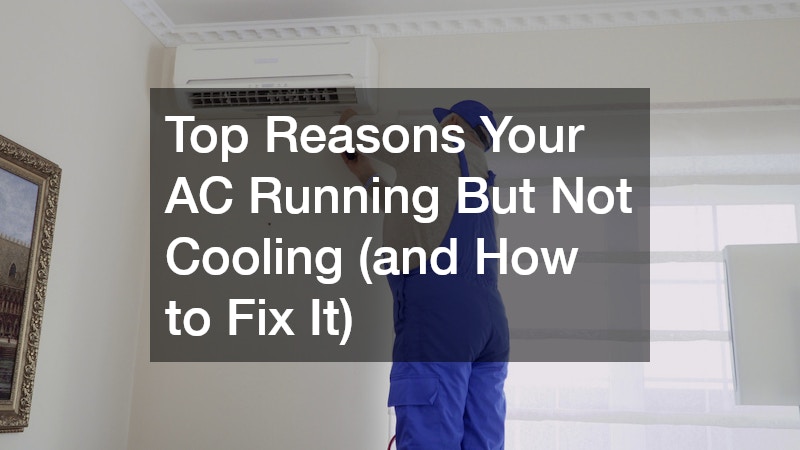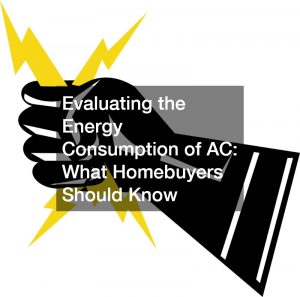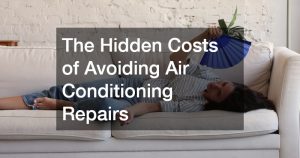Nothing is more frustrating than coming home to find your air conditioner running but not cooling. When this happens, your energy bills go up, but your comfort doesn’t improve. Fortunately, this is a common issue with many possible solutions. Understanding why your AC is blowing warm air helps you troubleshoot the problem and take action quickly — sometimes without even calling a technician.
In this guide, we’ll cover the most common reasons your AC might run without cooling, step-by-step troubleshooting tips, and preventive maintenance strategies to keep your home cool all summer long.
1. Check Your Thermostat First
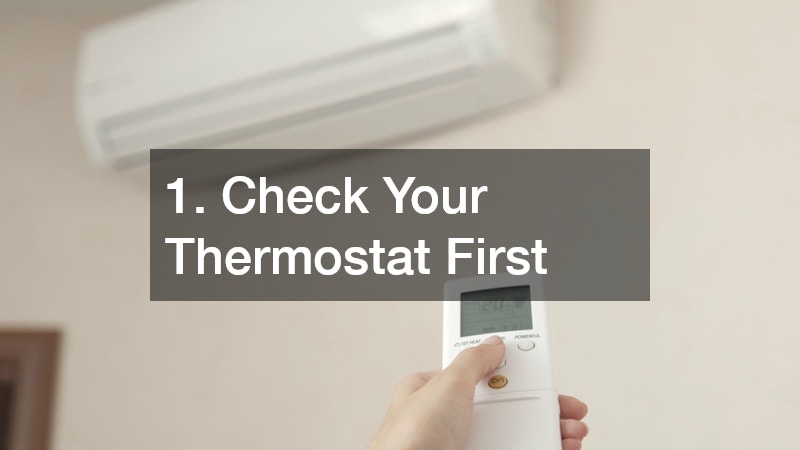
Your thermostat is the brain of your HVAC system, so if it’s not set correctly, your AC might run without actually cooling. This is one of the simplest problems to fix and should always be your first step before inspecting anything else.
Start by making sure the thermostat is set to COOL and not accidentally switched to FAN or HEAT mode. Then, lower the temperature a few degrees below your current room temperature to trigger the system. If nothing changes, your thermostat could have low batteries or a wiring issue.
Quick tips:
- Verify your thermostat is set to COOL mode.
- Lower the temperature setting by at least 3–5°F.
- Replace batteries if your thermostat uses them.
- Check if your thermostat screen is blank — this may indicate a power issue.
A malfunctioning thermostat can send the wrong signals to your AC system. If replacing batteries doesn’t work, you may need to recalibrate or replace it.
2. Dirty Air Filter
A dirty or clogged air filter is one of the leading causes of AC problems. When airflow is blocked, your system has to work harder to circulate air, which can lead to poor cooling performance. This issue is so common that HVAC professionals recommend checking your filter every month during peak usage seasons.
When filters are clogged, they restrict air movement, causing your evaporator coil to freeze and making your AC run longer without cooling your space effectively. The good news? This is one of the easiest problems to fix.
What to do:
- Check your filter every 30 days during summer.
- Replace disposable filters every 1–3 months.
- Wash reusable filters with mild soap and let them dry fully before reinstalling.
- Choose high-quality filters with a MERV rating of 8–11 for best performance.
Clean air filters not only improve cooling but also help keep indoor air free from dust, pollen, and allergens.
3. Frozen Evaporator Coil
The evaporator coil is responsible for absorbing heat from your home’s air. When airflow is restricted or refrigerant levels drop, the coil can freeze over, preventing it from doing its job.
You may notice warm air blowing from vents, ice forming on the coil or refrigerant lines, or water puddling around your indoor unit as the ice melts. Running your AC while the coil is frozen can cause damage to the compressor.
How to address a frozen coil:
- Turn off your AC immediately and switch the fan ON to speed up defrosting.
- Check and replace the air filter to restore proper airflow.
- Clear any blocked supply or return vents.
- If freezing happens again, call a professional to check refrigerant levels or inspect the blower motor.
Letting the coil thaw completely before restarting is critical. This step alone often restores normal operation if the freeze-up was caused by airflow restriction.
4. Low Refrigerant Levels
Refrigerant is what allows your AC to remove heat from the air. When levels are too low, your system will run continuously but won’t produce enough cool air. Unlike gas in a car, refrigerant doesn’t get used up — so if it’s low, there’s likely a leak somewhere.
Signs of low refrigerant:
- Warm air blowing despite the AC running
- Bubbling or hissing sounds near refrigerant lines
- Ice buildup on evaporator coils
- Higher energy bills without improved cooling
If you suspect a refrigerant issue, don’t try to top it up yourself. Handling refrigerant requires EPA certification, and simply refilling it without repairing leaks will only give temporary relief.
Your next steps:
- Turn off your AC to prevent further damage.
- Call a licensed HVAC technician to locate and repair the leak.
- Have the refrigerant level properly recharged.
Fixing refrigerant issues promptly can prevent compressor damage, which is one of the most expensive AC repairs.
5. Dirty Condenser Coils
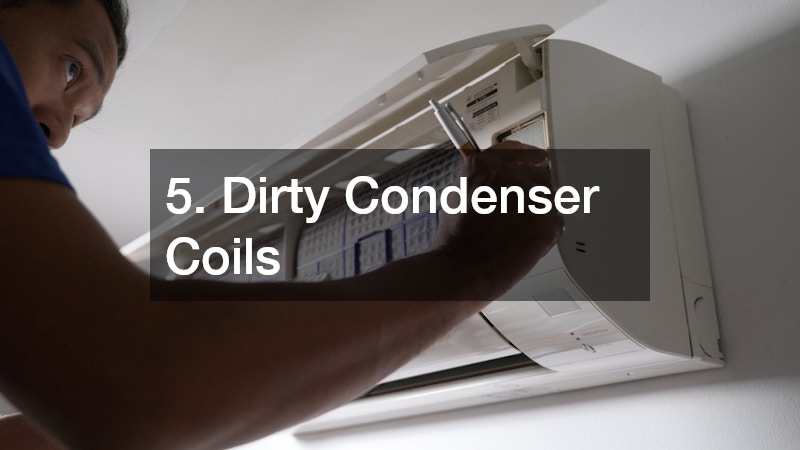
Your outdoor condenser coil plays a critical role in cooling by releasing heat from inside your home. When it gets covered with dirt, grass clippings, or leaves, heat transfer slows down, making your AC much less effective.
Cleaning the condenser coil is a relatively simple DIY task and should be done at least once per year.
Steps to clean the condenser coil:
- Turn off power to the unit at the breaker.
- Remove any leaves, weeds, or debris around the condenser.
- Rinse the coil gently with a garden hose from the inside out.
- Straighten any bent fins with a fin comb to improve airflow.
Keeping the coil clean allows your AC to run efficiently, lowering your energy bills and reducing wear on the compressor.
6. Blocked or Leaky Ductwork
Even if your AC is working correctly, blocked or leaky ducts can keep cool air from reaching your living spaces. This can make some rooms feel hot while others are comfortable, creating uneven cooling.
Warning signs:
- One room feels much warmer than others.
- You notice visible holes or loose connections in ductwork.
- Airflow feels weak coming from certain vents.
Possible solutions:
- Seal small gaps with UL-listed foil tape (avoid duct tape — it degrades quickly).
- Insulate ducts running through hot spaces like attics or crawl spaces.
- Have a professional do a duct leakage test if you suspect major losses.
Fixing duct issues not only improves cooling but also reduces wasted energy, saving money over time.
7. Electrical or Capacitor Issues
Electrical problems can also cause your AC to run without cooling. Capacitors provide the boost your compressor and fan motors need to start up. If a capacitor fails, your AC may hum or run the fan but fail to cool.
Because capacitors and wiring involve high-voltage electricity, this is not a safe DIY repair.
What to look for:
- AC makes clicking sounds but doesn’t start cooling.
- Fan runs but compressor doesn’t kick on.
- Burning smell from outdoor unit.
Next steps:
- Shut off power to the system if you suspect electrical damage.
- Call an HVAC technician to test capacitors and wiring safely.
- Have faulty parts replaced before restarting the unit.
Electrical issues caught early can prevent damage to expensive components like the compressor.
8. Undersized or Oversized AC Unit
If your AC system is the wrong size for your home, you’ll experience constant discomfort no matter how well it’s maintained.
An undersized unit will run constantly but never reach your set temperature, especially on hot days. An oversized unit cools the air too quickly and shuts off before properly removing humidity, leaving your home feeling damp and sticky.
Signs of improper sizing:
- AC runs all day without reaching target temperature.
- Short cycling (unit turns on and off rapidly).
- High humidity levels despite cooling.
If you suspect your AC is incorrectly sized, have an HVAC professional perform a Manual J load calculation to determine the right capacity for your home. Proper sizing improves comfort and efficiency.
When to Call a Professional
Some AC problems are too complex or dangerous to fix on your own. Knowing when to call a professional can save you time, money, and prevent further damage.
Call an HVAC technician if you notice:
- Refrigerant leaks or frozen coils that keep coming back
- Electrical burning smells or sparking
- Compressor not starting despite thermostat calls for cooling
- Major duct leaks or collapsed ductwork
Getting professional help ensures repairs are done safely and correctly, restoring cool air as quickly as possible.
Preventive Maintenance Tips
The best way to avoid future issues is to stay ahead of them with regular maintenance. Keeping your AC system in top condition not only improves performance but also extends its lifespan.
Simple maintenance checklist:
- Schedule professional tune-ups once a year, ideally before summer.
- Change air filters regularly to maintain airflow.
- Keep the outdoor condenser unit clear of weeds and debris.
- Check thermostat settings seasonally to make sure they are accurate.
- Inspect exposed ductwork periodically for leaks.
A well-maintained AC is less likely to break down, uses less energy, and keeps your home more comfortable.
Final Thoughts
When your AC is running but not cooling, don’t panic — most of the causes are straightforward and easy to address. From dirty filters and blocked coils to low refrigerant levels, identifying the root cause is the first step to restoring comfort.
Knowing how to troubleshoot common issues yourself can save money and prevent unnecessary service calls. Still, don’t hesitate to call a professional for complex issues like refrigerant leaks, electrical failures, or compressor problems.
By combining regular maintenance, timely repairs, and good troubleshooting practices, you can keep your system working efficiently and your home cool all summer long.
